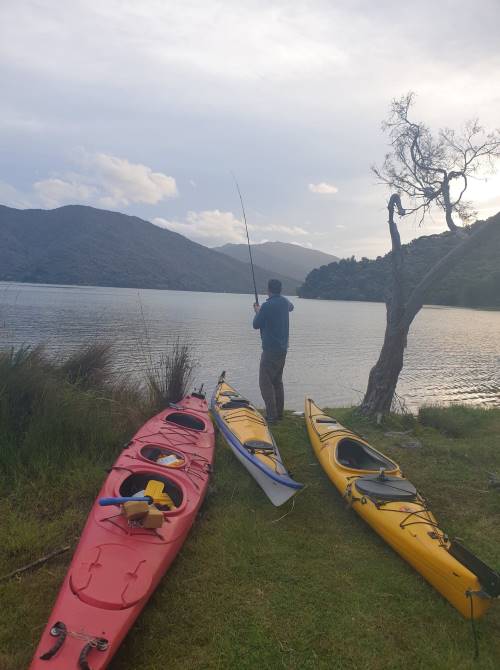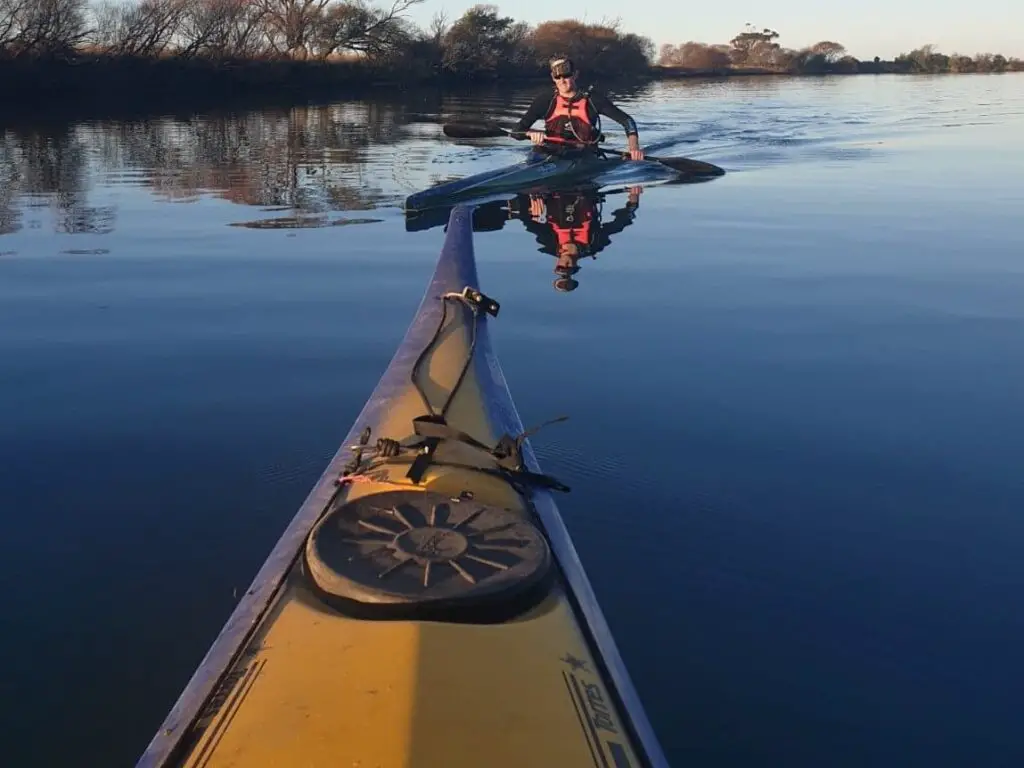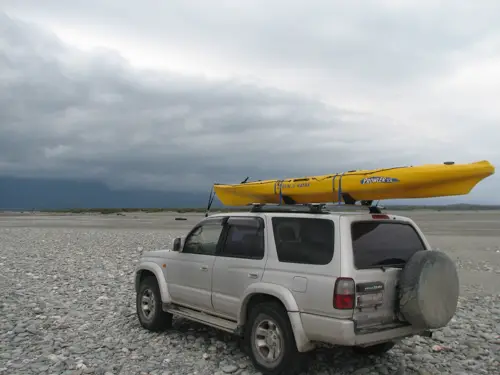I have two passions in life, one is fishing, the other is kayaking. So I often combine the two passions. While I am a mad keen kayaker, canoeing also holds a place close to my heart. I learned to paddle in a canoe, and have numerous happy childhood memories fooling around in them.
In this article, I will compare kayaks against Canoes to help you decide which is the best paddle watercraft for fishing.
My bias is towards kayaking. I feel in many ways they are the ultimate watercraft to fish from. They glide through the water, with maximum stealth and minimal disturbance but at the same time, they are capable enough to handle all but the roughest of conditions.
Fishing kayak vs Canoe? Which is best for fishing
I learned to paddle in Canoes, they are a lot of fun to paddle and their storage capacity can not be beaten. While Canoes are a great option, I feel fishing kayaks in most situations are better.
With regards to dimensions, both are similar with a wide range of widths and lengths available. Generally speaking, the longer a kayak the more efficient the whole. While a wider hull is more stable, but a skinny one is less table but offers less drag.
I will only use a canoe when I want to fish and camp in fairly sheltered water. They are also an excellent option when you want to portage between two waterways. Carrying a fishing kayak is hard enough even when empty, it will be a nightmare trying to carry one over rough ground when it is full of supplies.
Canoes are also excellent if there is more than one person. They are simply more spacious and there is a little more freedom to move around. Yes, there are two and three people kayaks, but they are generally long and very heavy.
Advantages of canoes
- Basic canoes are generally lighter than kayaks of the same dimensions.
- Much easier to portage, even when fully loaded.
- The open design makes Canoes super easy to load up with packs, coolers, and any camping gear you can imagine.
- Potentially easier to stand, and the higher sitting position can assist in sighting fish*
- Canoes generally have better seating for multiple people and interactions between them is easier.
Advantages of fishing Kayaks
- Easier to control in rough, and moving water.
- Much better internal storage to keep gear dry.
- Safer, nearly impossible to swamp- Easier to recover after a capsize
- Often sitting closer to the water for improved stability*
- Generally easier to paddle with a higher cruising speed.
- Generally better deck layout for mounting rod holders and other accessories.
* There are now extremely wide kayaks that are easy to stand on. Such kayaks often have raised seats that are easier to sight from. The raised seat also makes more powerful strokes possible. Such wide kayaks do usually paddle like barges and are extremely heavy. Generally better suited for shorter trips.

Sit on top kayak vs Sit inside kayak for fishing?
Recreational sit on top kayaks have made the sport a lot more accessible. Sit inside kayaks can be a bit daunting, and can be daunting in case of open water capsizing.
I own both a sit inside and sit on top. I paddle and fish from both. But to be fair, sit on tops are nearly always the better option for fishing.
The vast majority of sit on top kayaks and are relatively short and wide. These dimensions make them very stable for fishing, but a bit slow to paddle.
While longer, thinner hulls are more common in sit inside kayaks. This makes them better for longer trips.
Now, there are a few fishing kayaks with long thin hulls, they are an excellent choice for long distance trolling or if you are using it to reach the far end of a lake. One such fishing kayak is the Stellar Fisha that I reviewed here.
Advantages of Sit Inside Kayak
- Generally more streamlined with hulls designed for efficiency and touring.
- Much better when punching into a chop
- With a spray skirt they are warmer in cold river.
- Generally have a lot more internal storage.
- Generally have bulk heads and much better internal storage.
- More maneuverable, can use body weight to assist in steering.
- With skill and training rolling is possible. Although difficult with fishing rods attached.
- Sitting position is much closer to the water, allowing for extra stability despite a narrow hull.
- Often lighter and easier to carry.
Advantage of sit on top kayak?
- Wider with much better stability
- It is possible to stand and cast in some specialized fishing kayaks.
- Much easier to remount in case of a capsize.
- Much better deck layout for fishing accessories
- Easier to get into, and get out of.
- Self draining, no need to worry about the cockpit getting flooded.
What is heavier a Sit inside Kayak, Fishing Kayak or Canoe?
Weight is based primely on materials and dimensions. In this chart I am going to compare the weights of several plastic 12ft long kayaks and canoes with similar dimensions.
Keep in mind, that the weight does vary somewhat between brands, based on thickness of the plastic used and the number of integrated accessories. Boats, made from different materials such as fiberglass, Carbon or wood can also be significantly lighter.
In the table below, I tried to compare four somewhat similar watercraft that can be used for fishing.
Comparing the weight of various personal watercraft
| Watercraft | Brand name | Length | Width | Weight | Material |
| Sit on top fishing kayak | Ocean Kayak Terra 12 | 12’ | 28” | 55lb | Polyethylene |
| Single person canoe | Esquif Adiron Dack | 12′ | 31.5” | 39lb | Plastic Laminate |
| Basic sea kayak. | Perception Carolina 12 | 12’ | 26” | 49lb | Polyethylene |
| Pedal fishing kayak | Perception Pescador Pilot | 12′ 5″ | 34” | 85lb | Polyethylene |
How wide should a fishing kayak or canone be?
Most kayak fishermen should get a kayak or canoe somewhere between 27-31″ wide. Fly fishermen who wish to stand and cast might want to get a 35″ wide boat.
Generally speaking, you will want as narrow a kayak that is still comfortably stable to seat and fish from. What that is differs from person to person. Keep in mind, the winder the kayak the harder it is to paddle and the heavier it is to carry.
I paddle and race kayaks that are only 16 inches across, I can rest sidewise in a chop in an 18 inch kayak. I feel rock solid in a 20inch hull.
On the other extreme, I have seen people capsize kayaks with a 32″ wide hull. If you are a bigger paddler with poor balance, you will likely need a wider hull.
The more time you spend paddling, the more stable you become.
| How wide | How Stable | Is it possible to stand | |
| 50cm | 19 inches | Designed for touring more than sitting. Experienced paddlers can fish from such hulls in calm conditions. | Not for a normal person. |
| 60cm | 23 inches | High performance fishing kayak designed for speed and touring. With experience, most people should be comfortable enough sitting and fishing in calm conditions. | I have stood in mine, but the chance of swimming is high. I can not fish and stand. |
| 70cm | 27 inches | Standard long distance fishing kayak. New paddlers might feel unstable in choppy conditions. | Standing is possible if the floor is flat. Standing and fishing is not really possible. |
| 80cm | 31 inches | Stable fishing kayak. Most people will be comfortable but have seen larger novice fishermen capsize them when not paying attention. | Standing is quite comfortable, casting is possible in calm conditions. |
| 90cm | 35 inches | Extremely stable kayak. Still possible to capsize if caught in rolling surf or getting flipped by large waves, or violent white water. | Dedicated fly fishing kayak. Standing is easy in most conditions. |

How long should a fishing kayak or canoe be?
The longer the hull, the faster the boat (within reason). A long hull is safer, it makes punching into a strong headwind and chop easier. I have been pushed backwards by powerful gusts in even very efficient hulls at times. Nature can be scary.
A longer hull is also heavier. To keep the total weight under control, quite a few fishing kayaks are made shorter so performance starts to suffer.
10ft: This length and shorter are better suited for sheltered water and smaller ponds. You do not really want to paddle a 10ft boat into a strong headwind or in open water conditions.
13ft: This is a very popular length. A good option for shorter, and lighter paddlers.
15ft is my length of choice for open water kayak fishing. It has enough hull length for touring. With practice, 10 mile days are quite comfortable. I weigh 200lb and feel this is a good length.
18ft I sometimes paddle a Stealth Fisha that is 5.5m long (18 feet). It is very good for touring. I paddled 40 miles in it one day. I was fit, and my body was hurting but that is what such a hull is capable of doing.

